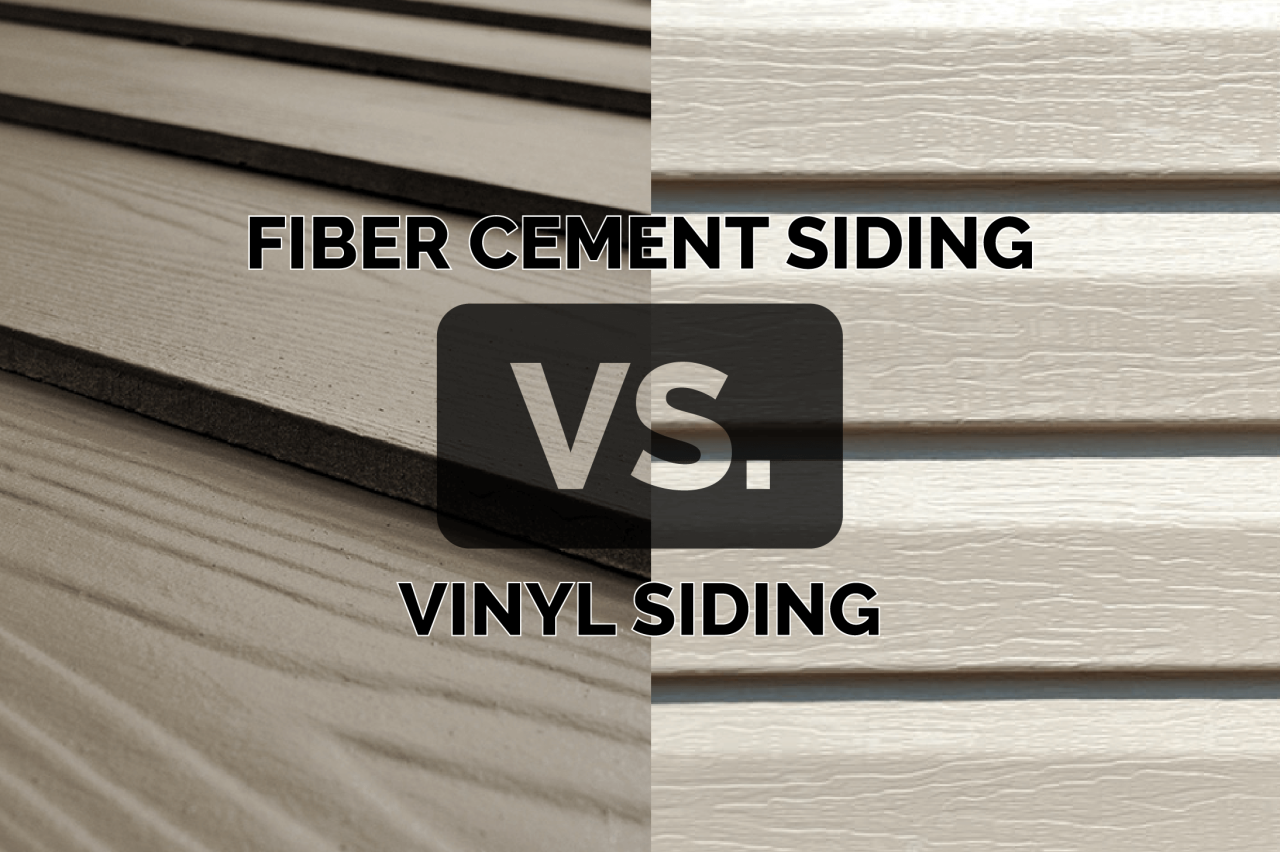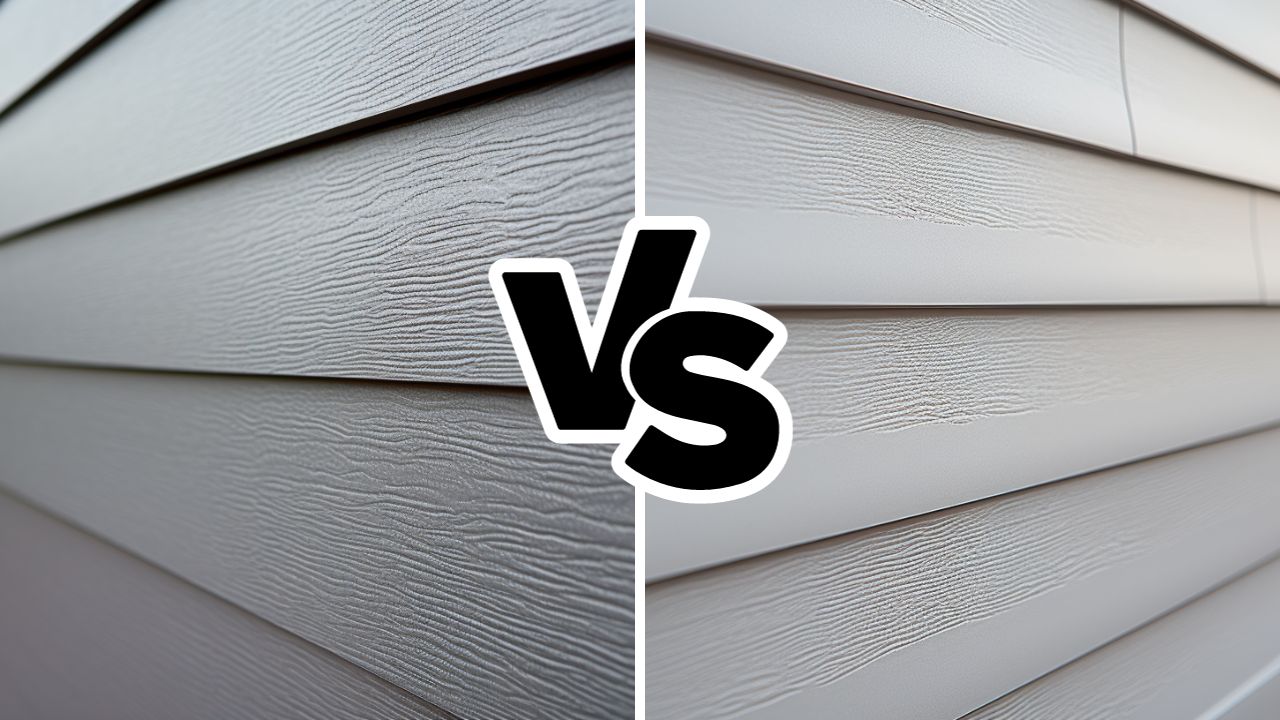Vinyl vs Fiber Cement Siding Comparison: Which One Comes Out on Top?
As we delve into the world of siding options, the comparison between vinyl and fiber cement siding takes center stage. Prepare to uncover the key differences, benefits, and drawbacks of each material in this informative exploration.
In the following paragraphs, we will break down the essential aspects of vinyl and fiber cement siding, shedding light on their characteristics and performance.
Vinyl Siding Overview

Vinyl siding is a popular choice for exterior cladding due to its versatility and affordability. It is made from PVC (polyvinyl chloride) resin, making it lightweight and easy to install.
Key Features of Vinyl Siding
- Weather-resistant: Vinyl siding is designed to withstand harsh weather conditions, including heavy rain, snow, and wind.
- Low maintenance: Unlike wood siding, vinyl siding does not require painting or staining. Simply wash it with soap and water to keep it looking fresh.
- Diverse styles and colors: Vinyl siding comes in a wide range of styles, textures, and colors to suit any architectural design or personal preference.
Durability of Vinyl Siding
Vinyl siding is known for its durability and long lifespan. It does not rot, warp, or corrode like traditional wood siding. With proper installation, vinyl siding can last for decades without needing replacement.
Maintenance Requirements of Vinyl Siding
- Regular cleaning: Vinyl siding should be cleaned at least once a year to remove dirt, mold, and mildew buildup.
- Inspection: Check for any loose or damaged panels and replace them as needed to maintain the integrity of the siding.
Styles and Colors of Vinyl Siding
- Traditional lap siding: Mimics the look of wood clapboard siding.
- Vertical siding: Adds a modern touch to the exterior of a home.
- Shake and shingle siding: Resembles cedar shakes or shingles for a rustic appearance.
Fiber Cement Siding Overview
Fiber cement siding is a durable and low-maintenance siding option made from a mixture of cement, sand, and cellulose fibers. This composition gives it strength, resistance to fire, insects, and rot, making it a popular choice among homeowners.
Advantages of Fiber Cement Siding
- High durability and longevity, lasting up to 50 years or more.
- Low maintenance requirements, only needing occasional cleaning.
- Resistant to fire, insects, and rot, providing added safety and protection to the home.
- Available in a wide range of colors and styles, mimicking the look of wood, brick, or stone.
Popular Brands Offering Fiber Cement Siding
- James Hardie: Known for their high-quality fiber cement siding products with a variety of textures and finishes.
- Allura: Offers a range of fiber cement siding options that are durable and aesthetically pleasing.
- Nichiha: Specializes in architectural-grade fiber cement siding that combines style and performance.
Installation Process of Fiber Cement Siding vs. Vinyl Siding
While both fiber cement and vinyl siding can be DIY projects, fiber cement siding is heavier and requires special tools for cutting and installation. Vinyl siding, on the other hand, is lightweight and easier to handle, making it a quicker installation process for many homeowners.
Durability and Longevity
Vinyl siding and fiber cement siding are both popular choices for homeowners looking for durable siding options. In this section, we will analyze the durability of vinyl siding in various weather conditions, compare the longevity of fiber cement siding to vinyl siding, discuss how each type of siding holds up against factors like moisture, pests, and impact, and share examples of real-life scenarios where one type of siding outperformed the other in terms of durability.
Durability in Various Weather Conditions
Vinyl siding is known for its durability in various weather conditions. It is resistant to extreme temperatures, including hot summers and cold winters, without warping or fading. Vinyl siding is also resistant to moisture, making it a great choice for areas with high humidity or frequent rain.
However, in very hot climates, vinyl siding may be prone to melting or warping.
Longevity Comparison
Fiber cement siding is known for its exceptional longevity compared to vinyl siding. While vinyl siding typically lasts around 20-40 years, fiber cement siding can last upwards of 50 years or more with proper maintenance. Fiber cement siding is highly resistant to rot, mold, and pests, which contributes to its long lifespan.
Resistance to Moisture, Pests, and Impact
When it comes to moisture resistance, fiber cement siding outperforms vinyl siding. Fiber cement is not susceptible to rot or mold, making it an ideal choice for humid climates. Additionally, fiber cement is not appealing to pests like termites, whereas vinyl siding may be more prone to pest damage.
In terms of impact resistance, both types of siding are relatively durable, but fiber cement is known to withstand impacts from hail or debris better than vinyl.
Real-Life Examples
In areas prone to severe weather conditions like hurricanes or tornadoes, fiber cement siding has shown to outperform vinyl siding in terms of durability. Homeowners in these regions have reported less damage to their homes when using fiber cement siding compared to vinyl siding.
Additionally, in areas with high moisture levels, fiber cement siding has proven to be a better long-term investment due to its resistance to rot and mold.
Maintenance and Care

Maintaining and caring for your siding is essential to ensure its longevity and aesthetic appeal. Let’s explore the maintenance requirements for vinyl and fiber cement siding, along with tips on cleaning and upkeep.
Vinyl Siding Maintenance
- Regularly wash the siding with a mixture of water and mild soap to remove dirt and grime.
- Inspect for any cracks, holes, or damage that may need to be repaired promptly.
- Avoid using harsh chemicals or pressure washers, as they can damage the siding.
Fiber Cement Siding Maintenance compared to Vinyl
- Fiber cement siding requires less maintenance overall compared to vinyl.
- It should be inspected for damage and repainted every 5-10 years to maintain its appearance.
- While it is more durable, fiber cement siding may need occasional touch-ups or repairs.
Tips for Cleaning and Upkeep
- For vinyl siding, use a soft cloth or brush to scrub away any stains gently.
- For fiber cement siding, use a mild detergent and water solution to clean the surface.
- Regularly trim vegetation near the siding to prevent damage and maintain airflow.
Cost Implications of Maintenance
- Vinyl siding tends to be more affordable to maintain due to its lower maintenance requirements.
- Fiber cement siding may require periodic repainting, which can increase maintenance costs over time.
- Overall, the cost of maintenance for both types of siding should be factored into your decision-making process.
Final Thoughts

In conclusion, the choice between vinyl and fiber cement siding ultimately boils down to your specific needs and preferences. Consider the factors discussed here to make an informed decision that will enhance the beauty and durability of your home.
Essential Questionnaire
Is fiber cement siding more durable than vinyl siding?
Fiber cement siding is generally considered more durable than vinyl siding, especially in harsh weather conditions.
What are the maintenance requirements for vinyl siding?
Vinyl siding typically requires minimal maintenance, such as occasional cleaning with a hose and mild detergent.
Are there specific brands known for offering high-quality fiber cement siding?
Popular brands like James Hardie and Allura are well-known for their quality fiber cement siding products.
How do the installation processes of vinyl and fiber cement siding differ?
Vinyl siding is usually quicker and easier to install compared to fiber cement siding, which requires more specialized tools and skills.
What are the cost implications of maintaining vinyl versus fiber cement siding?
Vinyl siding tends to have lower maintenance costs over time compared to fiber cement siding, which may require more upkeep.